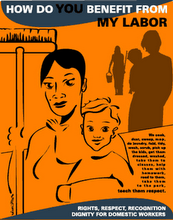Globe and Mail
TAVIA GRANT
September 11, 2007
Newcomers are facing severe challenges finding work in Quebec, while they tend to gain employment much more easily in Manitoba and Alberta, a national study showed yesterday.
Immigrants throughout Canada struggle for work in the first decade after they arrive, especially in the first five years. But nowhere is the problem more acute than in Quebec, where they experience "substantially" higher unemployment rates than Canadian-born people - regardless of how long they've been in the country, Statistics Canada said.
Statscan used immigration figures gathered last year from its labour-force survey to analyze the immigrant labour market, focusing on people from the ages of 25 to 54. The resulting study paints a contrasting picture of how immigrants fare from province to province.
Most immigrants who've lived in Canada for a decade or longer find jobs at the same rate as Canadian-born people as they become more integrated.
In Quebec, however, even established immigrants - those who have lived in Canada for 10 years or more - can't seem to find work. Their unemployment rate in the province was 9.2 per cent last year, compared with 6.3 per cent for Quebec at large.
Linguistic challenges may be one reason.
"There may be a greater linguistic mismatch, the French language skills to Quebec versus the English language skills to the rest of Canada," said Morton Weinfeld, chairman of Canadian Ethnic Studies at McGill University in Montreal. He believes "there is still a large number [of immigrants] to Quebec that speak either English or neither language ... that fact alone could explain the weaker economic integration."
Other reasons may bethat many immigrants tend to attend school or stay home to take care of their families, the study suggested.
"Another factor that could explain higher unemployment rates among immigrants in Quebec could be related to the countries of birth of immigrants living in Quebec compared to other provinces," the study states, adding that the topic will be discussed in a future report.
On the flipside, the jobless rate for established immigrants in Atlantic Canada was just 4.1 per cent - less than half the region's 8.9-per-cent rate.
By last year, most of Canada's immigrants came from Asia, particularly India and China. About a fifth of Canada's population is born outside the country, one of the highest proportions in the world.
Immigrants will take on an even greater importance in the years ahead as Canada copes with an aging population and looming labour shortages. If current rates continue, immigration could account for virtually all net labour-force growth by 2011, the report states.
First-generation immigrants may have growing pains in integrating into the Canadian work force, but the problem eases with the second generation, Dr. Weinfeld pointed out.
"The real proof of the immigration and integration process is ultimately going to be with the children of immigrants, how they will be faring," he said. "Take a stroll through the campuses of Canada's major universities and research centres and institutes, particularly in the sciences and in commerce. See who's enrolled and who's graduating. Enough said."
Over all, newcomers are much more likely to have a university education than Canadian-born residents, Statscan reported. Thirty-six per cent of working-age immigrants had at least a bachelor's degree, while among those born in Canada, the proportion was just 22 per cent.
The report also shows stark gender differences.
"Labour market outcomes were better for immigrant men than their female counterparts, and ... young immigrant women in particular have struggled," the analysts wrote.
Regardless of how long they'd been in Canada, immigrant women had higher unemployment rates than both immigrant men and Canadian-born women.
The unemployment rate for women who've been here for five years or less was 13 per cent last year, higher than 10.3 per cent among men in the same group and 4.6 per cent among Canadian-born women.
Immigrants are more likely to work in factories, professional and technical services and accommodation and food services.
Immigrants who've been in Canada for less than 10 years, meanwhile, have tough times establishing themselves here. Very recent arrivals have a jobless rate of 11.5 per cent, more than double the Canadian average of 4.9 per cent.
The need to adjust to a new life in Canada, earn credential recognition and be retrained are some reasons for the gap. Immigrants themselves say the most serious difficulties in entering the work force are a lack of Canadian experience, lack of recognition of their credentials and language barriers, Statscan says, citing a 2003 study.
Immigrants tend to find work fastest in Alberta, where a strong economy has created labour shortages, and Manitoba, which has a program that matches skilled workers to employment before they land.
Integration is so successful in Manitoba that even recent immigrants had higher employment rates than Canadian-born people in other provinces.
Ontario is still the largest provincial destination for immigrants, with British Columbia in second spot.
Among cities, Toronto, Vancouver and Montreal are home to most immigrants. In terms of jobs, newcomers tend to fare better in Toronto and Vancouver than in Montreal.
Down and out in Quebec
Even after more than five years in Canada, immigrants living in La Belle Province have double the jobless rate of native-born Canadians.
Unemployment rates
SHARE OF IMMIGRANTS IN POPULATION AGED 25-54, 2006 BORN IN CANADA IMMIGRANTS LESS THAN 5 YEARS IMMIGRANTS 5-10 YEARS
Nfld., Labrador 8.9 N.B. (Atlantic) * *
PEI N.S. Sask. 3.7 * *
Que. 6.3 17.8 13.4
Man. 3.2 6.8 *
Alta. 2.6 5.8 4.7
B.C. 3.7 9.5 5.1
Ont. 4.4 11.0 7.0
Canada 4.9 11.5 7.3
*Data unreliable/unavailable
SOURCE: LABOUR FORCE SURVEY
For Stats Can release on the study: http://www.statcan.ca/Daily/English/070910/d070910a.htm
et en français:
http://www.statcan.ca/Daily/Francais/070910/q070910a.htm
http://www.theglobeandmail.com/servlet/story/LAC.20070911.IMMIG11/TPStory/National
--
skip to main |
skip to sidebar

















Blog Archive
-
▼
2007
(540)
-
▼
September
(22)
- Protestors target Finley in support of blind Alger...
- Refugee advocate arrested at Lacolle border crossing
- La lutte pour le statut de Kader s'est transporté ...
- Refugee overload
- Charkaoui demande à nouveau la liberté
- France: une 4e loi sur l'immigration en débat
- Immigration au Québec : besoin de 60 000 immigrant...
- Canada’s New Government to expand CBSA training fa...
- Chechen girls die entering Poland
- Commission Bouchard-Taylor: les experts divisés
- Immigration raid a crisis school hadn't planned for
- He paints seagulls and longs to be free
- Deportee can stay to change religion
- C’est plein de trous
- Immigrant unemployment most acute in Quebec
- Forgive refugee loans, recommends immigration group
- Gitmo North's Last Prisoner in Limbo After 6 Years
- Immigrants welcome - as long as they conform
- Un producteur expulse un prêtre
- Syria severely restricts Iraqi refugee influx
- Security Certificates and Detention: the governmen...
- Les certificats de sécurité et la détention : le g...
-
▼
September
(22)


Qui sommes nous:
Solidarité sans frontières est un réseau basé à Montréal qui lutte en faveur de la justice et de la dignité pour tou-te-s les sans-statut. Nous sommes un regroupement de migrant-e-s, d'immigrant-e-s, réfugié-e-s et leurs allié-e-s. Nous mobilisons pour toutes ceux et celles qui se battent contre la déportation, la détention et les certificats de sécurité.
About us:
Solidarity Across Borders is a Montreal-based network of migrants, immigrants, refugees, and allies engaged in the struggle for justice and dignity for migrants and refugees. We mobilize for all who are caught in the immigration regime and for all who fight against deportations, detentions, and security certificates.


Labels:
- War on Terrorism/Guerre contre le terrorisme (81)
- Fortress North America (64)
- Secret Trials/Proces Secret (58)
- Exploitation: Immigrant Workers/Travailleurs-EUSES immigrantEs (45)
- Migrant Resistance (37)
- Sanctuaire/Sanctuary (35)
- Detention (31)
- "Reasonable" Accomodation (30)
- Deportation (29)
- Fortress Europe (26)
- Racism (22)
- Indigenous Resistance (15)
- Propaganda (14)
- Police Harrasment/Harcelement policiere (10)
- Racial Profiling/Profilage Racial (10)
- Guantanamo (6)
- Anti-racism/Contre le racisme (4)
- Palestian Refugees/RéfugiéEs PalestinienNEs (4)
- Solidarity Across Borders (4)
- Solidarité sans frontières (4)
- Don't Ask Don't Tell (3)
- unionization/syndicalisation (3)
- Guantanamo North (2)
- LGBTQ (2)
- Labour (2)
- People's Commission (2)
- Police State/Etat policier (2)
- White Supremacy (2)
- Women (2)
- Raids (1)


Info:
(514) 848-7583
sansfrontieres[at]resist.ca
www.solidarityacrossborders.org

Contributors


Links:




